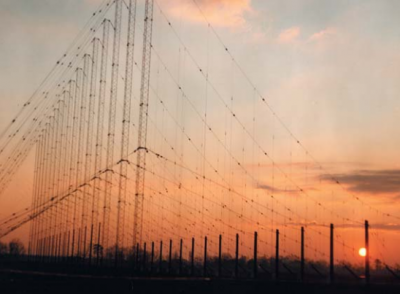ELIZABETH CITY – It’s been the most exciting example of economic development in his region, and Wayne Harris was thrilled that the newly completed Amazon Wind Farm U.S. East was about to go fully operational.

Then out of the blue, said Harris, the director of the Elizabeth City-Pasquotank County Economic Development Commission, a letter to an incoming Trump administration nominee surfaced last week, seeking help to shut down the state’s first wind facility because of national security concerns.
Supporter Spotlight
Signed by 10 state legislators and a retired general, the letter contends that the 104 turbines at the site present a risk because of their potential to degrade radar signals at a nearby facility. But the Navy, responding to inquiries, said that the wind farm is compatible with its mission.
On Wednesday, the development commission issued a scathing rebuke to the legislators’ letter in a resolution urging Trump’s transition team “to treat this request with the inaction it deserves.”
Honoring the legislators’ request, the resolution said, would “render (developer) Avangrid’s $400 million investment worthless, constitute an unprecedented confiscation of a fully-approved private-sector capital investment by the government and send a terrible message to other businesses considering investment in North Carolina.”
The electricity generated at the site is to be sold to online retail giant Amazon to power current and future cloud data centers.
Widespread Support
Not only are farmers here earning a total of $320,000 a year in lease payments, Harris said, Pasquotank – one of the state’s poorest counties – is collecting $270,000 a year in property taxes, which will increase 1.5 percent annually for 30 years.
Supporter Spotlight
When the wind farm was being built, Harris said, there were 200 people employed; there are still about 70 workers at the job. And the facility will permanently employ 10 to 15 people, paying an average salary of $80,000 – more than three times a typical salary in the county. An added benefit is that the land around the turbines can still be farmed, but now there are nice new dirt roads the farmers can use.
“It enjoys widespread community support,” Harris said. “There’s really nothing not to like about this project locally.”
What the state legislators apparently didn’t like – or trust – was President Obama’s pro-wind energy stand. Those who signed the letter to Gen. John Kelly, Donald Trump’s selection to serve as secretary of the Department of Homeland Security, include the Republican leadership in the legislature: House Speaker Tim Moore, Senate leader Phil Berger, Senate Majority leader Harry Brown and House Majority leader John Bell.

U.S. coastline. Photo: Raytheon Corp.
Concerns about the wind farm, as expressed in the letter, were centered on what signers viewed as potential interference of the Relocatable Over-the-Horizon Radar, or ROTHR, system in Chesapeake, Virginia. The radar, in use since 1993, is critical to tracking illegal or threatening activities, including drug trafficking.
“In our opinion, due to the consequences at stake, this wind project should never have been permitted to be built,” the legislators wrote.
The legislators contend that the 2014 agreement between the developer and the Defense Department does not include measures to shut down the facility “if there is 10% degradation of the ROTHR signal, or 25%, 50% or even 100%!”
“This totally unacceptable situation came about due to the current (Obama) administration’s promotion of unscientific and nonsensical ‘all of the above’ energy source … at essentially any cost.”
The legislators added that they were “very hopeful” that Kelly and the Trump administration would have “a considerably different energy perspective.”
Sen. Brown, who reportedly led the charge to send the letter, did not respond to several requests for comment.
Kelly, while serving as Marine Corps Commander, U.S. Southern Command, told the Senate Armed Services Committee in March 2014 in his “posture statement” that he had concerns about ROTHR interference from the then-planned Amazon wind farm, as well as wind facilities in Texas, where another radar system is located.
“These wind farms could and likely will adversely impact our ROTHR systems, the only persistent wide-area surveillance radars capable of tracking illicit aircraft in Latin America and the Caribbean,” Kelly said. “We are working within the Department of Defense and with developers and stakeholders to develop potential mitigation solutions, but I have little confidence we will succeed.”
The legislators assert that all the turbines at the site are within 28 miles or closer to the ROTHR, which a study has shown, they say, could interfere with radar. Absent shutting down the wind farm, they want stricter rules from the military over operation of the turbines.
‘An Ideological Situation’
State Rep. Bob Steinburg, R-Chowan, however, was not consulted about the letter. Nor were county officials in Pasquotank or Perquimans counties that the site straddles.

“I didn’t know anything about it,” Steinburg said, “and I’m the representative of the district where the wind farm is located.”
Steinburg, who said the project has brought much-needed money to the area, is planning to visit the wind farm on Tuesday with legislators Moore and Bell and several others.
“I do believe we are going to get this worked out,” he said. Not only is the project popular with residents of his district, he said, renewable energy is favored by a majority of state residents.
“It’s an ideological sort of situation we find ourselves in with these folks,” Steinburg said. “I’m a strong conservative. However, I’m not a closed-minded conservative.”
One of the references cited in the letter is a link to an Aug. 29, 2015, article in the right-wing, populist news and opinion site Breitbart News titled, “How Obama’s Environmental Policies Are Undermining the US Military and National Security.”
Another reference the letter includes is a link to a wiseenergy.org, a website published by John Droz, who lives in Morehead City. Droz, a well-known anti-wind energy activist who prefers to call himself an independent physicist, said that some of the legislators – he declined to say who – did consult with him before the letter was drafted to learn more about the “situation.”

“They asked me for my two cents,” Droz said. But he denied he is anti-wind energy, despite his history of crusading against other wind projects, including the proposed Torch Renewable Energy wind and solar project in Carteret County that was ultimately abandoned in 2014.
“Yes, I have a record opposing unscientific energy solutions,” Droz said. “Our federal and state policies are not based on science. They’re written by lobbyists.”
Droz said that Obama’s pro-wind energy policies may have influenced the military’s decision to allow the Amazon facility to operate so close to the ROTHR system.
In a draft of his letter to Steinburg, Droz asserted that military personnel, including communications staffers, know who is in charge.
“These people are also keenly aware of the politics involved here,” he wrote, “so it is extremely unlikely that they will say anything that will offend their Commander-in-Chief.”
Navy Didn’t Contact Legislators
The Navy’s Forces Surveillance Support Center has operational responsibility for the radar installation in support of its counter narco-terrorism mission, according to written information provided by Katisha Draughn-Fraguada, public affairs officer for Naval Support Activity Hampton Roads.
The Navy did not contact the legislators to express any concern about the Amazon project, she said.
Modeling done at the site in 2014 by scientists at the Massachusetts Institute of Technology and others determined the acceptable number of turbines at certain distances from radar to ensure that the project will not interfere with ROTHR, the Navy said. Additional field measurements are planned to validate the modeling results.
Other details provided by the Navy include:
- Wind projects are evaluated by the Defense Department to determine if they are compatible with military missions. Separate evaluations of such projects near ROTHR systems are also coordinated with the Navy’s Mitigation Response Teams.
- Electric power lines, wind turbines, solar power towers and electrical transmission towers are all potential hazards to military aircraft, military operations or ground-based surveillance radars and are all subject to compatibility evaluations. A clearinghouse website was created in 2010 to provide a single point of contact for agencies, local governments, developers and landowners.
- Modeling by MIT predicts that the 104 turbines will not create an unacceptable impact that exceeds the limits of the radar system to perform the operational mission. Field measurements taken at the completed wind farm will be done to validate the modeling and measure impacts. Any degradation that exceeds predicted impacts could impact the ability of the surveillance system.
- Except for national security or defense purposes, which would require curtailment of operations, if field testing measurements at the wind farm exceed the allowable interference, the Navy and the developer must confer with experts to identify the cause and remediation strategies.
- The U.S. Navy’s Naval Supply Systems Command in April 2016 awarded Raytheon Co., based in Waltham, Mass., up to $104 million to perform the operational support and maintenance of the ROTHR system. In addition to a receiver site in Chesapeake, there is a ROTHR transmit site in New Kent County, Virginia.
- According to Raytheon, ROTHR is a high-frequency radar system that provides long-range detection and tracking of aircraft and ships. Each radar covers more than 2.5 million square miles.
- The ROTHR system is capable of being relocated within a specific time period.
- Other ROTHR facilities are in Texas and Puerto Rico. Wind energy projects similar to Amazon located or proposed near those systems have undergone the same type of compatibility evaluations and scientific modeling.
As expected, Defense Department staff were at the Amazon site last week doing tests to evaluate data to ensure continued compatibility, said Paul Copleman, communications manager for Avangrid Renewables.

“We’ve been working alongside them for years now,” he said.
“If the wind farm threatens their capabilities and readiness, we would not have been allowed to build it. The military knows how to protect its bases. They’re not going to compromise that for our wind farm or any wind farm.”
Copleman said in an email that Avangrid is “in constant contact with many regulators and officials” at every level of government, but declined to be specific.
“We continue to update them on our progress, and the tremendous local benefits as we move forward on this important investment in North Carolina,” he said.
Others who signed the letter include coastal legislators Sen. Norm Sanderson, R-Pamlico; Sen. Bill Cook, R-Beaufort; and Reps. Chris Millis, R-Pender, Pat McElraft, R-Carteret, and George Cleveland, R-Onslow. Retired Maj. Gen. Robert Dickerson, who spent 16 years based at and deployed from Camp Lejeune, also signed the letter.

In a statement emailed on Thursday, Cook said that his position has remained consistent.
“Three taxpayer subsidized wind projects that create few jobs for North Carolinians should not take priority over the hundreds of thousands of jobs and tens of billions of dollars that we could jeopardize if we fail to stand up for our military,” he said. “Make no mistake – if we fail to fully protect our military installations, decision-makers in Washington could award them to states that will, and our local communities will be left picking up the pieces.”
Rep. Walter Jones, R-N.C. also addressed Kelly with a cover letter supporting clarification of the safety of the radar system operation.







